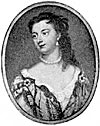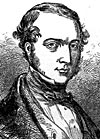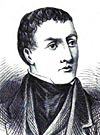< Previous | Contents | Next >
TRAVELLERS.
JOHN DEANE, (1679 (?) -1761), born at Nottingham, was, because of his inclination, apprenticed to a butcher or a drover, and getting into bad company led to deer stealing, and fear of the operation of the law led to flight to the sea, where he succeeded so well that at the capture of Gibraltar he had risen even to the rank of captain. When he was about thirty years of age his father and brother helped him to purcnase a small vessel, which he called the "Nottingham Galley," but it was wrecked, and the crew were reduced to dreadful sufferings on a barren island, from which they were rescued with the loss of everything, and he eventually arrived at home again; but in 1714 he commanded a ship of war in the service of the Czar of Muscovy, and in 1721 and for seventeen years, he was British Consul in the ports of Flanders and at Ostend, from whence he returned and settled at Wilford. He built in succession, the two houses East of the Green, where he resided over twenty years. In the field at the back of the house he was violently assaulted and robbed, which led to the robber being hanged. He was in his eighty-second year when he died, and his wife died the next day. The tomb is in the centre of Wilford churchyard.
Mr. W. H. G. Kingston, the popular writer for boys, has woven the story of his life in a book, ''John Deane; Historic Adventures bv Land and Sea." (London, Griffiths & Co.).
MANSFIELD PARKYNS, (1823-1894), Woodboro' Hall, was great-grandson of the famous wrestler Sir Thomas Parkyns, of Bunny. He was born at Rud-dington, and proceeded to Cambridge, but left after a year's residence, and went for a tour in Abyssinia, Egypt, etc., where he continued nine (?) years. He was appointed attache to the Embassy at Constantinople. He returned in 1852, and became one of the "lions of the day, married a daughter of Baron Westbury, and they had eight daughters. He published "Life in Abyssinia," and settled at Woodborough. He was appointed Official Assignee in Bankruptcy and later Comptroller, retiring in 1884. He gave much time to improving Wood's School, and made the beautiful carved oak choir stalls in Woodborough Church at which, and the Tower screen, he worked for two years. (Buckland, p. 37).
WILLIAM F. WEBB, (1829-1899), who in 1860 bought the Newstead estate from the executors of Colonel Wildman, had travelled extensively in Africa, and there he met Livingstone and formed a lifelong friendship. On his return voyage, when passing through the Red Sea, two Lascars fell overboard, and when the Captain refused to stop the ship for the sake of saving two mere Lascars, Mr. Webb instantly plunged overboard, saying "They will stop for a passenger."
DAVID LIVINGSTONE, of whom his companion Sir John Kirk says, "he was the bravest man I have ever met, with perfect frankness and sincerity, an iron will combined with a beautiful gentleness of manner," was a personal friend of Mr. Webb, and in 1864 stayed for some time at Newstead Abbey, in which he wrote his book, "The Zambesi and its Tributaries." His daughter Agnes was partly educated at Newstead. Stanley made repeated visits, and gave lectures at Nottingham and Mansfield.
G. Cartwright, Sir C. Fellows, Lord Savile, Sir H. Willoughby,
See "Families."
VARIOUS PERSONS.
MARGERY DOUBLEDAY was a washerwoman in Nottingham, who by her will in 1544, left the rent of a close in Broad Marsh, then being 20s. per annum, to the sexton of St. Peter's church, on condition of ringing the bell, which she purchased, every morning (except Sunday) at four a.m., to wake up the washerwomen for their work. The good dame had experienced the benefit of early rising, and had prospered with it, and so wanted to extend its operations. Was that the field where a hundred years ago was St. Peter's Workhouse and Burial Ground, now its Schoolrooms and the houses West of Newbridge Street? If so, who sold it, and who got the benefit? She also left another field for prayers to be said on her behalf.
LADY ANNE STANHOPE, who died in 1587-8, being the 30th year of Queen Elizabeth, has in Shelford Church a monument with a record worth observation. She was the wife of Sir Michael Stanhope, to whom had been granted by Henry VIII. the manor of Shelford, and other estates in the county, formerly belonging to the suppressed monastery. Sir Michael was akin to, and associated with, Lord Protector Somerset, who in the days of Edward VI. was executed, owing to the machinations of the rival Duke of Northumberland, and Sir Michael shared the same fate, and his widow lived thirty-five years afterwards. During that period she brought up all her younger children in virtue and learning. She kept a worshipful house, relieved the poor daily, gave good countenance and comfort to the Preachers of God's Word, spent most of the time of her latter days in prayer, using the Church where God's Word was preached. She died in the faith of Christ, with hope of a joyful resurrection. (See monument in Shelford Church).
MRS. ANNE BALLARD, who died in 1626, and whose memorial brass plate was on the wall of the old church at Radcliffe on Trent, must have been a useful woman according to the inscription, for "she lived in good reporte," to the age of eighty-three, and
"Aske how she lived, and thou shalt know her ende,
She dyed a Saint to God, to poore a Friende."
ELIZABETH HOOTON, (d. 1671, aged about 71), of Skegby, was one of the first local converts made by George Fox in 1647-8, when he worked as a shoemaker at Mansfield Woodhouse and preached in the district. He was then a young man of about twenty-two, and she was a married woman of middle age. Deeply religious, strong minded, and of a zeal for the Lord of Hosts that nothing could subdue, she deemed it her duty to bid farewell to her husband and children and become the first itinerant woman preacher of the new doctrine. A storm of opposition greeted her, and according to Fox's Journal in 1650, she was imprisoned "in ye ffen country, for preachinge ye gospell." This was followed by imprisonment at Derby; at York Castle, practically two years; in Beckenham prison five months; in Lincoln prison three months. During these periods of captivity she boldly demanded a reform of the many abuses which then disgraced our gaols—reforms for which Elizabeth Fry more successfully pleaded, one hundred and fifty years later. In each case she wrote to the local authorities, although this course naturally tended to increase the harshness of her own punishment, and indignation appears to master discretion in these documents. Thus we are told, "Her earliest extant letter is addressed to the Mayor of Derby, and draws a contrast between the pitiable state of the poor prisoners and his own comfort and honour, warning him of the fate of Dives, 'if he will not regard the poor and in prison.'" ("Quaker Women 1650-1690," M. R. Brailsford) .
When Oliver Hooton, her husband, died about 1661, leaving her well off, she would enjoy neither ease nor comfort thereby, but hearing how the Quakers were persecuted in New England she desired to suffer with them. Although described as "an old woman," she endured the many hardships of the voyage, and reached Boston in the summer of 1661. Here the Quakers were treated with far greater severity than in England, women were whipped at the cart's tail from town to town, one had been hanged. She and the elderly friend who accompanied her were promptly imprisoned and condemned to banishment. After suffering "weariness and painfulness, hunger and thirst, perils of water, and perils in the wilderness," they eventually reached Rhode Island. From there they went to Barbados, and after another encounter with the governor at Boston, returned to England, where she was confronted by fresh trouble. Her son had been imprisoned for refusing to take the oath, and in consequence of an unjust distraint the farm had to be sold. Although she courted martyrdom, she apparently did not "take joyfully the spoiling of her goods," and failing to obtain redress at the Leicestershire Sessions she went to London to lay her case before King Charles II., and persistently waylaid him, thrusting letters into his hand, and endeavouring to preach to the courtiers and soldiers at Whitehall. The only outcome appears to have been that the King granted her a certificate permitting her to settle in any of the British colonies, which enabled her to return once more to Boston, this time accompanied by her daughter Elizabeth, and with the intention of buying a house and land, to be used as a Quaker meeting-house and hostel, and the land for a burial ground. These plans were, however, effectually thwarted by the refusal of the authorities to allow her to purchase land. Five years of bitter persecution followed, until at last she realized that her ischeme was impracticable and returned to England about 1666-7—to leave it again on her last adventure in 1671. At that time George Fox determined to visit the Quakers in the West Indies, and twelve Friends volunteered to go with him, Elizabeth Hooton being one. After a seven weeks voyage they reached Barbados, where they stayed for three months, and then in January 1672 set out for Jamaica where Elizabeth died, being about seventy-one years of age. Her career is very difficult to follow, and still more so to assess the good.

LADY MARY WORTLEY MONTAGU, (1689-1762) was the eldest daughter of Evelyn Pierrepont, who became in succession Earl of Kingston, Marquis of Dorchester, and Duke of Kingston. Her mother having died, Lady Mary had to act as hostess and carve the meat at the table, so she took lessons "three times a week, and in order to perform her duty before her father properly, and without interruption, she was forced to eat her own dinner alone, an hour beforehand." She married Edward Wortley Montagu, but the marriage does not appear to have been a happy one. Mr. Wortley having been appointed to the embassy at Constantinople, she went there, and she became the authoress of "Letters from the East," which showed ability. The one point to be made here is that at Adrianople, having noticed the practice of inoculation for small-pox, she had her son inoculated, and took much pains to introduce the practice upon her return to England, thereby conferring considerable benefit.

John Walter MP
"THE WALTER FOUNTAIN," at the junction of Lister Gate and three other streets, Nottingham, was erected in 1865-6 to perpetuate the memory of the connection of John Walter, Esquire, one of the proprietors of the "Times" newspaper, as M.P. for Nottingham, with the people and the town. He died in 1847, and his son, John Walter, Junr., who also became M.P. for Nottingham, erected the Fountain in 1866.
MPS. MARY MARLOW, (1808-1878), Basford, before the days of registered midwives and nurses, voluntarily undertook to do the office of midwife for poor women without fee or reward, going to any part of the parish at any hour, at a moment's notice, and this she kept up for forty to fifty years.

"BENDIGO" must have a place among the notables of Nottingham. His name was
WILLIAM THOMPSON, (1811-80), who was born in New Yard, Parliament Street, his father being a skilled lace-maker. The lad took a wild course, but was fond of fishing, skilled in sports, and being trained as a boxer, at twenty-one commenced his career as a prizefighter. In 1835 he defeated Ben Caunt, and later beat Langan; Deaf Burke; Ben Caunt a second time; then Tom Paddock, and so he was Champion of all England. When thirty-nine he retired from the prize-ring, but he had contracted the habit of excessive drinking, and so he went down, down, until he had during twenty years, been convicted by the magistrates, and sent to jail, twenty-eight times. Hearing Richard Weaver, "the converted collier," preach, he became converted too, and under the care of Jemmy Dupe, he had a hard struggle to overcome his appetite, and separate from his companions, but he succeeded, and went on the platforms in many large towns, and toil his story to immense audiences. He died at Beeston, but was buried in Fox's burial ground (St. Mary's Cemetery) in his mother's grave, and a life-sized recumbent lion in stone was his monument.
In the State of Victoria, Australia, a city and county was named Sandhurst, after a former governor, but the inhabitants refused the name, and adopted that of "Bendigo," in honour of his pluck, and by that name it is now legally known. (C. Bonnell).
